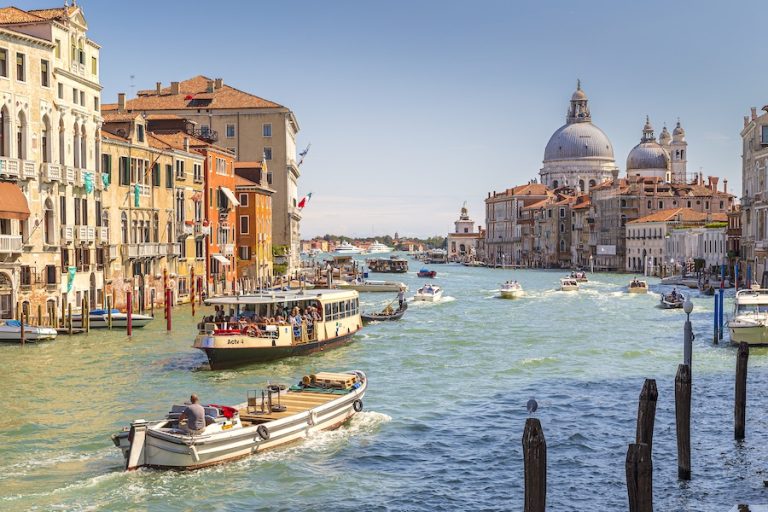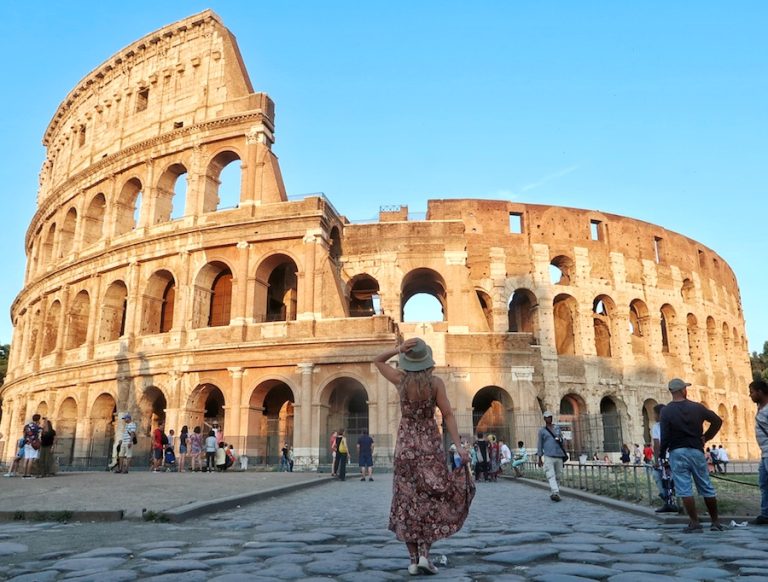Rome | The Ultimate 3 Day Itinerary
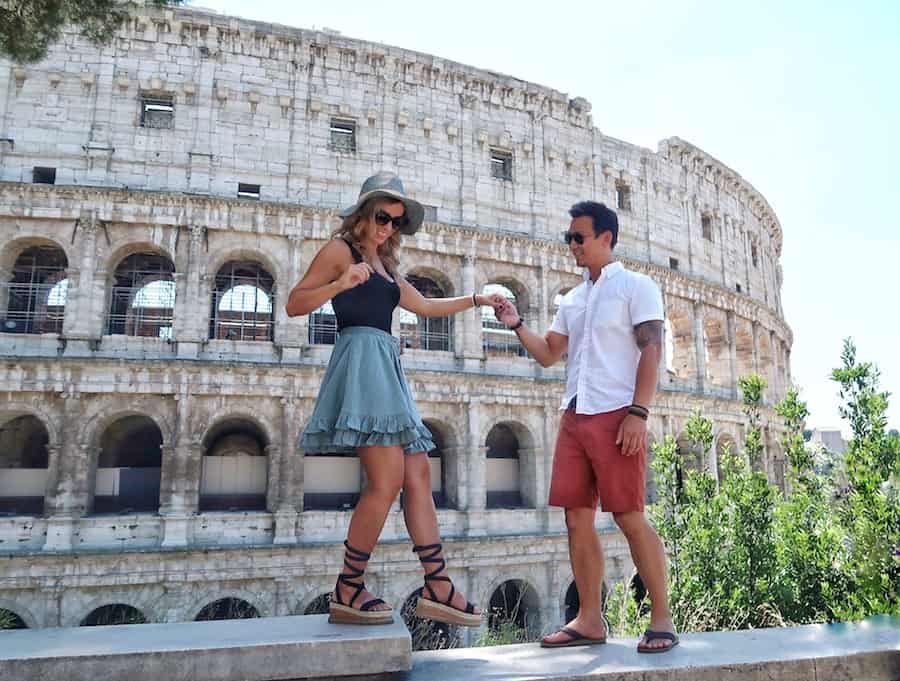
If you’re visiting Italy, and only have 3 days in Rome, then planning your trip can be a daunting task. There is so much to see that it would take a lifetime to see it all. I’ve been to Rome twice so I wanted to put together this 3 day itinerary to help first timers get the most out of their visit. It covers all the highlights of the city and even a little more if you have time.
The city of Rome is beautiful, romantic, sophisticated, timeless and also slightly expensive. There are so many incredible sights, amazing museums and delicious food on offer. It’s also a great place to learn as much or as little as you want, by yourself, with your partner or even with the little ones. Rome literally has something for everyone.
Rome was, of course, the capital of one of the largest and most powerful empires in history. The influence of ancient Rome could be seen in all of its territories across Europe. Many areas of todays Western culture can be traced back to ancient Rome such as language, engineering and agriculture. You won’t have to walk very far in the city today to see traces of a once great civilisation.
Getting In
Rome is one of the most visited cities in the world so the chances of getting a cheap airline ticket are pretty good. Check your ticket carefully as there are two international airports in Rome – Leonardo da Vinci Airport (Fiumicino) and Ciampino.
Most flights will land at the busier Fiumicino, with more Ryanair flights landing in Ciampino. The best way to get to the city is by bus. A return ticket costs around €9 from either airport and will take you to Termini station. You can even book online to secure your seat.
The Leonardo Express train (€14 one-way) also runs between Fiumicino and Termini station but not from Ciampino. You would need to get a bus to Ciampino railway station first before getting a train into Termini. A bit more effort but the trip will only cost a few Euros in total.
Read More | The Best Of Florence In 2 Days
Getting Around

Rome’s public transport is very easy to use but to the best way to see the city is on foot. Put on a comfortable pair of shoes and open your Google Maps app and you’re good to go.
We arrived at Termini station by train from Florence and it didn’t take us long to work out how to use the Metro. We all know how confusing those underground maps can be! Just be aware that the Metro stops running at 11:30pm (1:30am on Fridays and Saturdays.) The buses however, run throughout the night.
Tip | While Rome is very safe (both in the day and at night), and has a very low crime rate, you should still be aware of pickpockets. The Metro is one of the prime areas due to the crowds and lack of general awareness. Just keep your bag in front of you, keep cash in your pockets to a minimum and save the ‘I Love Rome’ t-shirt until you get home.
Roma Pass
The Roma Pass is a great option for those are going to be using public transport. The 72 Hour Pass is a great choice for a 3 day Rome itinerary. It costs €38.50 and allows unlimited use the Metro, trams and all buses (except airport transfers.) The pass also allows free entry to the first 2 sites of your choice and reduced tickets to all others thereafter. There is also a 48 Hour Pass for €28 with free entry to just one site.
Many tourists purchase the pass as allows fast track entry to certain sites. This sounds like the perfect reason to go ahead and buy one. Except that these people haven’t planned everything out properly! The Roma Pass can be worthwhile if you constantly use public transport for sightseeing. However, like most historic cities, Rome is best appreciated on foot.
So why didn’t we want to buy the Roma Pass? Well, as tempting as it is, there is no need to by any kind of queue skip in Rome. I’ll tell you how to avoid the queues later. Also, after calculating the entry costs to 2 sites (Colosseum and Castel Sant’Angelo) it would work out to be nearly €20 more for the 72 Pass. Also, the most expensive ticket in Rome, the Vatican Museums, are NOT included on the pass.
I’m not saying that the pass is not a good option. It does come with a cool map! But work out whether you really need it. If you follow my tips in this itinerary, you might find that it’s better to plan ahead and save those few extra Euros for something else. With both of us preferring to walk, we didn’t think the pass was worth it.
Rome Itinerary – Day 1
Day 1 of our Rome itinerary is a long one and will involve quite a lot of walking. Actually, so will Day 2 and Day 3! This is Rome after all! I recommend waking up nice and early to maximise the time you have. Wear sensible shoes and take an water bottle with you – there are plenty of drinking fountains located around the city. You can, of course, use the Metro/buses to get around quicker.
Italian Breakfast
An Italian breakfast is much lighter than your typical eggs and bacon with toast. La colazione is normally a small affair in a local cafe. Order your coffee of choice (or tea if you prefer) along with a baked good and you’re eating just like the locals! We had this every morning in Rome and we particularly enjoyed the croissants filled with chocolate or pistachio!
Spanish Steps
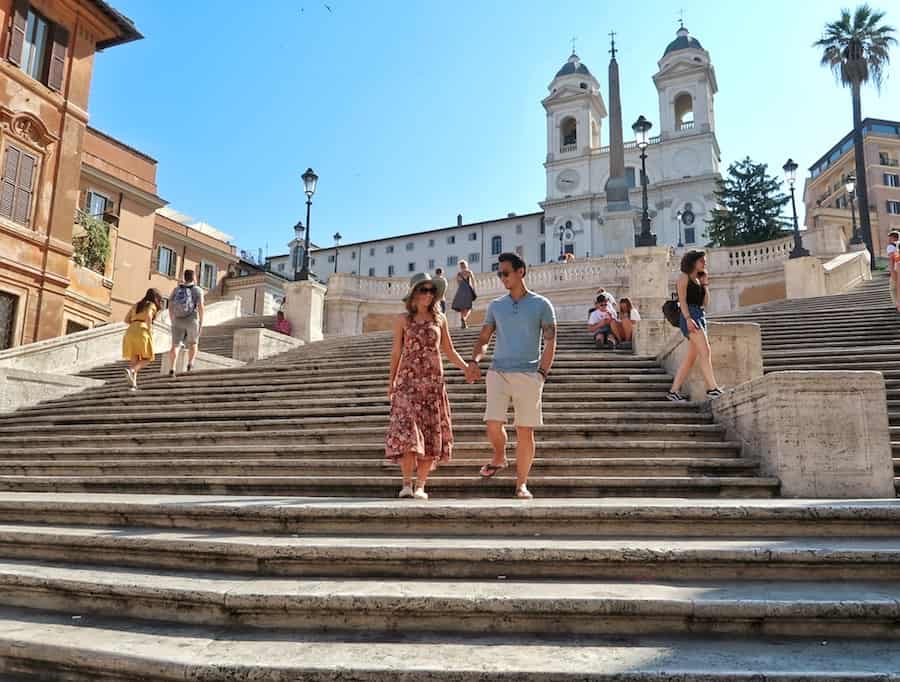
The Spanish Steps is where we began our first action-packed day in Rome. We stayed in a budget hotel near the centre, and walked here in about 20 minutes passing all the designers shops along the Via dei Condotti.
Arriving at the Piazza di Spagna (Spanish Square) you’ll see the Fontana della Barcaccia at the base of the 174 steps. Built in 1724, the steps links the Spanish Embassy to The Holy See at the bottom to the church at the top – the Trinità dei Monti.
Take as much time as you need to just sit and soak up the atmosphere. Make sure you arrive early to avoid the crowds of selfie takers. It’s also worth taking a climb to the top and taking a look around the church.
Update | As of August 2019, new laws have been put in place to stop tourists from sitting on the steps. This is to try and protect the monument but it does seem a little extreme. Anyone caught sitting on the steps can expect a loud whistle from a police officer and even a fine of €250!
Trevi Fountain


A short 10 minute walk from the Spanish Steps is the ever Instagrammble Trevi Fountain. The largest Baroque fountain in the world is simply stunning. Built in the 18th century, the name comes from the Italian tre (three) via (streets) as the fountain is at the meeting point of three roads.
Unless you arrive at 7am, it will be crowded at the fountain whatever time you arrive. Find yourself a place to sit, if possible, and just enjoy the massive statues that decorate the fountain. Just remember to behave – laws have been put in place to ban all eating and drinking near historic fountains and can land you a fine of €240!
The one thing that everybody has to do at the fountain is, of course, the Trevi coin toss. This will ensure your return to Rome. Now the correct way to do this is, with your back to the fountain and using your right arm, throw a coin over your left shoulder into the fountain. I did this incorrectly in 2012 but somehow I made it to Rome again… only to do it wrong… again!
The money that is thrown into the Trevi Fountain is used for the maintenance of cultural sites and social welfare projects. Not bad consideration the council scoops out €1.5 million each year!
Now is probably a good time to refuel. The short walk between the Trevi Fountain and the Pantheon has plenty of restaurants for lunch.
Pantheon

Prepared to be awestruck by one of Rome’s best preserved ancient buildings. The Pantheon is estimated to be 2000 years old and was a temple to the Gods before being converted into a Catholic church.
There is unlikely to be a big line to get into the Pantheon. Just remember to cover up as it is a church after all. The interior of the church is beautifully decorated with Italian marble and uniquely lit from the oculus – the Pantheons only light source coming from a hole at the top of the dome.
Tip | Don’t miss the tomb of one of the greatest painters of the Renaissance era, Raffaello Sanzio. Better know as Raphael in English, his tomb is alongside his fiancee’s – Maria Bibbiena, to the left of the Pantheon.
Piazza Venezia

Walking to Piazza Venezia from the Pantheon will take about 10-15 minutes. You’ll pass many many cafes and gelaterias so why not stop along the way for a coffee or gelato?
The Piazza Venezia is the central hub of Rome and the main attraction is the imposing Vittorio Emanuele II Monument. Take a walk up to the stairs and see the Tomb of the Unknown Soldier and the many beautifully crafted statues. You can also check out the museum inside or take a lift to the top of the monument for some spectacular panoramic views (€7).
Next to the Vittorio Emanuele II Monument are the Capitoline Museums. We didn’t have time to go inside but we did have a look around as we wanted to see the square that was designed by Michelangelo. The Capitoline Wolf is located inside the museum but there is a replica found on the side of Palazzo Senatorio. Walk around the square and you’ll get some great views of Roman Forum too.

If you have time then maybe you want to head to the Bocca della Verità, or the Mouth of Truth, located at the Santa Maria in Cosmedin Church. It’s a 10 minute walk from the Capitoline Museums and you’ll pass Marcello Theater on the way. The origins of the Mouth of Truth is still up for debate. The only thing we know is that it will bite off the hand of any liars who dare to insert theirs into the mouth. (Warning – this may be a lie!)
Circus Maximus
From the Bocca della Verità (if you went) you take a walk through the Circus Maximus. Although it might look like any old park these days, Circus Maximus was a Roman chariot-racing stadium during the Roman times. It held over 150,000 spectators and the first of its kind in Rome, eventually becoming the model for all circuses throughout the Empire.
Evening
Walking past the Circus Maximus and taking a left will take you to Rome’s most famous landmark, the Colosseum. This is a great time to admire the amphitheatre and take some great photos. Especially if you time it right and catch the sunset.
By now you will probably be hungry. Unless you have deep pockets, do not go into any restaurant where you can still the Colosseum. Eating dinner with a view of Rome’s most famous site comes at a premium. Even a coffee can cost over €5! Just walk away from the Colosseum and check the menus until you find one that suits your budget.
Now that the sun has set, you have a few options. I know it’s been a long day but what better way to finish than to go back to the Trevi Fountain or the Spanish Steps for the nighttime atmosphere? Why not do both, like we did?
Tip | There’ll be plenty of vendors trying to sell you selfie sticks, water and little Colosseum models. Just politely say no if you are not interested! We saw tourists get very aggravated at these vendors and even witnessed a selfie stick fight! There’s just no need for unnecessary anger!
Rome Itinerary – Day 2
Day 2 begins with another nice early start! Have a quick breakfast and then it’s time to get seriously educated in Roman history! The main attraction today will be The Colosseum. Before you worry about how long to queue however, read on to find out how we didn’t have to wait more than 10 minutes!
Palatine Hill
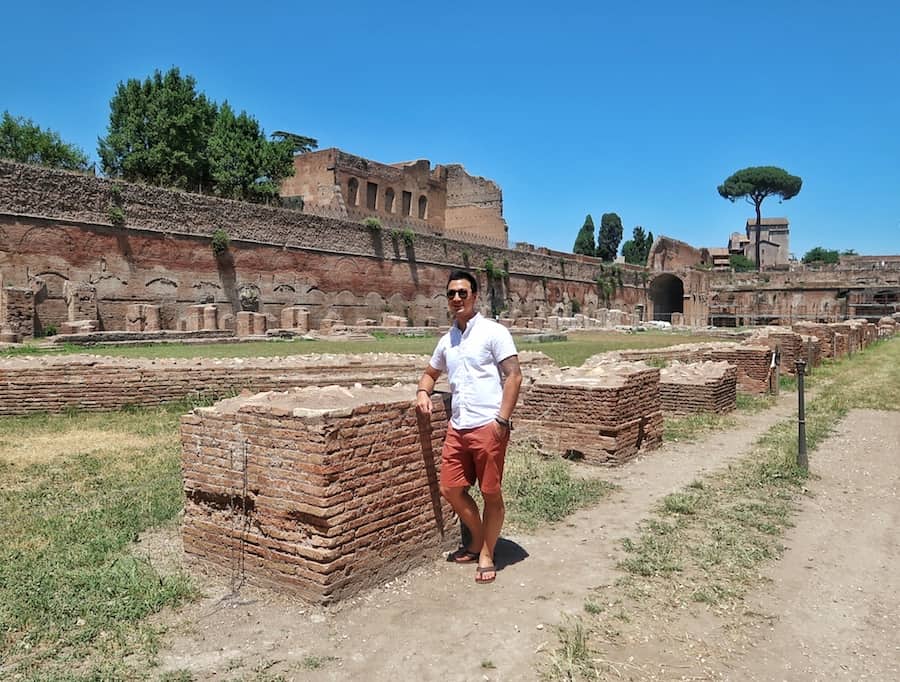
Paletine Hill is the most famous of Rome’s seven hills and is the starting point for Day 2. Palatine Hill was considered the most desirable neighbourhood during Ancient Rome and was the birthplace of Augustus, the first Roman Emperor.
This is a great site to start the day you’ll ancient ruins like the House of Augustus, the Flavian Palace and the Stadium of Domitian. The best part of starting the day at Palatine Hill though, is the entrance ticket!
You’ll notice that there is no queue to get into Palatine Hill (or least there wasn’t the two times I’ve visited.) Even if there is a queue, it will be small and you’ll wait 10 minutes at the most. The ticket cost €12 and is a combination ticket that also includes entrance to the Roman Forum and the COLOSSEUM! Meaning that later you can walk past all those tourists waiting in line just to purchase their ticket because they haven’t read my blog!
Tip | The one thing to be careful of is that timing of your visit to the Colosseum. When we purchased our ticket, the lady said we would have be at the Colosseum at ‘x‘ time. That only gave us one and a half hours to see Palatine Hill and the Roman Forum. These sites really deserve more time. Either have a huge breakfast so you can spend more time at these sites or speak to the ticket office about your timed entry!
Roman Forum

Walking through Palatine Hill, you’ll eventually follow the path down to the next site on the itinerary, the Roman Forum. Il Foro Romano, as it is in Italian, was the main centre of ancient Rome. It was similar to a city square and was where all things religious, political, social and commercial occurred. They were common throughout the Roman Empire but none were as grand as the one in the city of Rome.
Explore the forum and discover the amazing ruins such as the Temple of Saturn and the Arch of Septimius Severus. Learn about the Vestal Virgins and honour the great Julius Caesar who was cremated at the Temple of Caesar after his assassination.
When you think you’ve learned all there is to learn about ancient Roman life, it’s time to make your way to Rome’s most famous landmark.
Colosseum

One of the new 7 wonders, the Colosseum was the most visited attraction in the world in 2018! The largest amphitheatre in the world was built in 80AD and would host gladiator contests, hunts, executions and even dramas to its 65,000 crowd. Today, the Colosseum is partially ruined because of earthquakes and thieves. You can clearly see that one side is higher than the other.
After walking past the huge queue and showing you Colosseum ticket, you’ll be inside be inside within minutes. Walk around the interior and try to imagine what it would’ve been like to watch gladiators try and kill each other. Take a walk up the second level and you can see the museum and learn how the Colosseum was built.

For those who want a bit more from their Colosseum experience, there are now tours available that take you up to the top tiers that were once closed to the public. There are also options to explore underneath the Colosseum as well as guided night tours. Tickets are available from the official Coop site and sell out weeks in advance!
Tip | This itinerary is intended for those who are travelling on a budget. Meaning that I haven’t included the price of any guides as we didn’t have one ourselves. I do feel that the best way to appreciate Palatine Hill, the Forum and the Colosseum is with a guide. That’s why I downloaded a free audioguide and took my earphones. It’s much better than walking around and just looking at some ruins. Rick Steves was my audioguide throughout Italy and I had a great time with him!
Tajan Forum
Had enough Roman history yet? Well, if you haven’t, you can always visit the Trajan Forum. As you walk from the Colosseum to Piazza Venezia, you see all the ruins on your right hand side. Tickets are €16 so you might decide to just take a peek a the columns and the old markets from the side (like we did.)
Depending on your time, you’ll hopefully be passing Piazza Venezia at night. Like many sites in Rome, visiting at night is just as spectacular as seeing it in the day. The Vittorio Emanuele II Monument is another one of those landmarks that you just can’t miss when it’s lit up at night.
Rome Itinerary – Day 3
The last day of the itinerary, day 3 is another busy day (is there any other?) so wake up early, grab a quick breakfast and get ready for another amazing day in Rome! You’ll be visiting the home of the Catholic Church so if you don’t want to refused entry then please dress appropriately. Cover your shoulders and nothing above the knee. Lecture over!
Tip | The secret to skipping the long queues at the Vatican is by buying your ticket in advance from the official website. These timed tickets will cost €17 (plus €4 pre-booking fee) and allows access to the Vatican Museums and the Sistine Chapel. If the tickets are sold out on the required date then there are plenty of other options available at Viator.
Vatican Museums
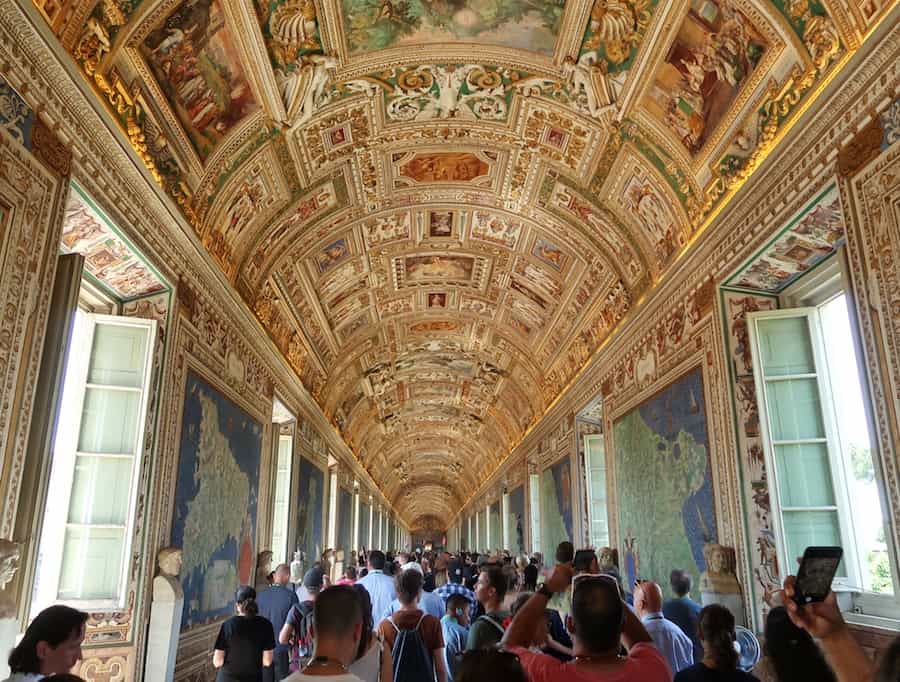
With an area of 0.44km² and a population of around 1000 people, Vatican City is the smallest country in the world! Officially named Vatican City State, it is the home of the Pope and head of the Catholic Church. The first stop in the city will be the Vatican Museums.
The Vatican Museums is one of the largest of the largest in the world, containing around 70,000 works of art, with only 20,000 on display. In 1506, Pope Julius II founded the museums and works of art have been amassed over the centuries ever since.
Once of the highlights of the Vatican Museums are the Raphael Rooms. Four beautifully frescoed rooms by the great Raffaelo Sanzio! Raphael (in English) was commissioned by Pope Julius II to paint what was intended to be a suite of apartments.
I’m going to recommend Rick Steves audioguide again for the museums. I think that without it, I wouldn’t have loved the experience as much as I did (I loved his description of the School of Athens). If you follow the route on his app then this will lead to straight to the Sistine Chapel.
Sistine Chapel
The Sistine Chapel would’ve just been like any other chapel, until Pope Julius II commissioned a certain Michelangelo to paint the ceiling in 1508. The ceiling is one of THE great Italian Renaissance works with the scene depicting the Creation of Adam being one of the most iconic paintings in history.
Michelangelo would create another masterpiece 25 years later in the Last Judgement. The huge fresco depicts the second coming of Christ and the final judgement of all humanity. A popular but grim subject, scholars believed Michelangelo was not the same who painted the ceiling years before.
After admiring all the frescos (and Raphael’s tapestries) it’s time to move on to St. Peter’s Basilica. If you follow the regular exit, you have a short walk to the front of the basilica but we took the shortcut you may have heard about. In the far corner opposite the Last Judgement, there is a door that is reserved for tour groups. There may, or may not be a guard checking your tickets but we just went with the masses as it was very crowded in the chapel anyway!
Tip | The rules inside the Sistine Chapel say no photography and no talking. Understandable since it is a holy place and flash photography damages artwork. Having been to the chapel twice I can tell you that the rules were not followed all of the time. So I guess it depends who’s working security that day.
St. Peter’s Basilica
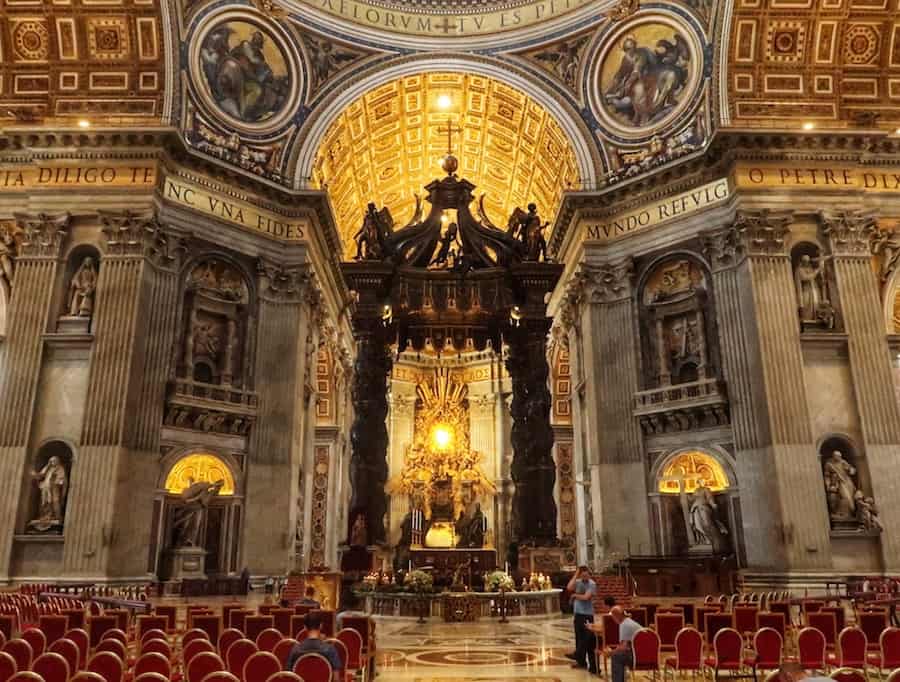
If you did take the secret exit (or maybe you were already on a tour) then you’ll come out just beside the basilica. The church itself is free to enter although you might want to take a quick detour and climb the dome (€8 or €10 with the lift.) The climb is well worth the Euros as you get incredible views over St. Peter’s Square and all its columns.
St. Peter’s Basilica is the largest church in the world and said to be built on Saint Peter’s burial sight. Peter was one of the twelve apostles of Jesus and the first leader of the early church. His tomb is directly below the altar.
The church was shaped by Renaissance architects and artists that included Bremante and Raphael. But it Michelangelo who became the principle designer. The interior of the church can be seriously neck-damaging as you’ll spend so much time gazing at the amazing artworks on display. Don’t miss Michelangelo’s Pieta or Saint Peter’s crucifixion site.
St. Peter’s Square
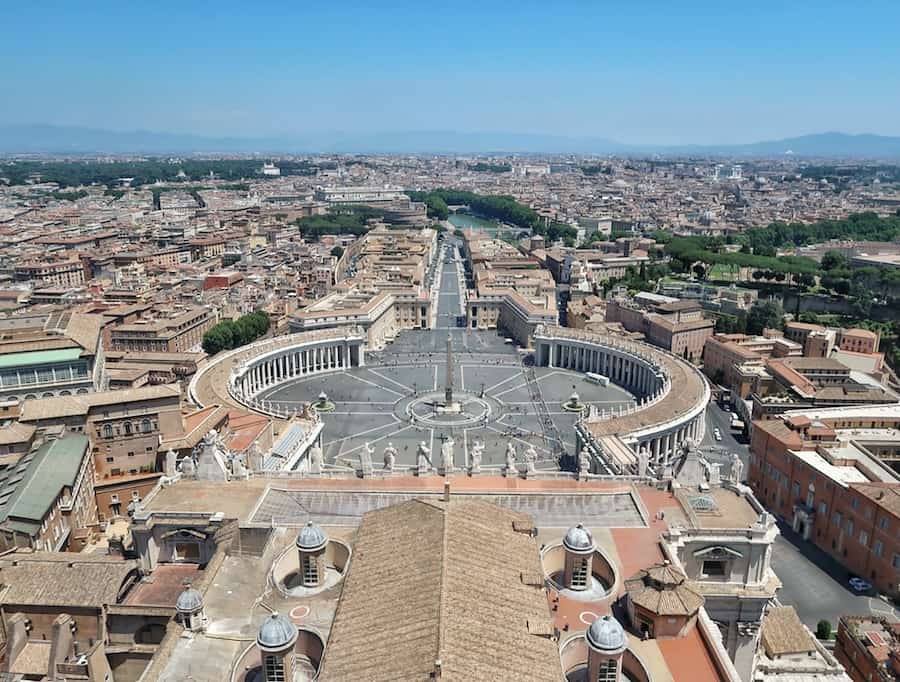
Leaving the church, you’ll find yourself walking onto St Peter’s Square. This is where the masses gather to catch a glimpse of the Pope every Wednesday (ticket required) and Sunday. You can admire the ancient Egyptian obelisk and the colonnades that surround the square or even send a postcard using one of the Vatican post boxes.
After seeing the museums and St Peter’s Basilica, you’re probably starving. We certainly were! Just as you leave St. Peter’s Sqaure towards Castel Sant’Angelo you’ll pass many restaurants and cafes at reasonable prices. You can tell all your friends later about the time you had lunch in the smallest country in the world!
Castel Sant’Angelo

Castel Sant’Angelo was originally a mausoleum for the Roman Emperor Hadrian and his family. The tomb was converted into a fortress in the 5th Century and today is a museum dedicated to the history of the castle itself.
Entry to the Castel Sant’Angelo costs €7.50 and there isn’t normally a large queue. If you go between Thursday and Sunday, you can visit the site right up till midnight. This is great for those summer months as you can climb to the top and witness the beautiful scenery as you watch the sun setting over all of Rome.
Now there’s nothing left to do but to find a nice restaurant and enjoy dinner with a nice glass of wine.
Have More Time?
There is, of course, so much more to see than what I’ve suggested here. If you have 4 days in Rome, or more, then you can really dive into all the historic sites. It is just not possible to see every single column or ancient stone or statue!
A first time visit to Rome should include the very best and most popular sites and that is the thinking behind this 3 day itinerary. Also, the itinerary stays fairly central, which is important when time is limited.
For those who do have more time, you might want to visit the Borghese Gallery and Borghese Gardens, see the Baths of Caracalla or the ancient road of the Appian Way. There are also nice beaches near Rome, with Santa Marinella and Santa Severa just a short train journey away.
Is Rome Worth A 3 Day Visit?
Rome is one of the great European destinations and was well worth seeing over 3 days!

The itinerary may seem a little ambitious but, with a bit of forward planning, 3 days in Rome is the perfect amount of time to see the best of the city. You never have to walk far before you arrive at another stunning landmark. Just make sure you don’t end up waiting for your tickets at the Colosseum and Vatican Museums and you’ll save hours of your precious time.
Personally, I love ancient Roman history and I studied art at school so I may be a little bias when I say that Rome is one of my favourite European cities. I can guarantee that once you’ve visited the Eternal City, you’ll feel the same!
Read More | How To Spend One Day In Milan
I hope that this 3 day itinerary has given you the perfect base in which to plan your trip to Rome. If you liked this post, or want to know anything else, please leave a comment. Thanks.

